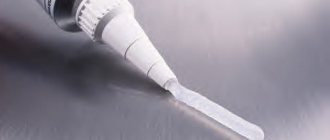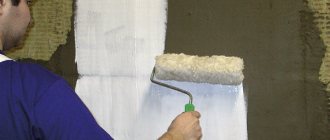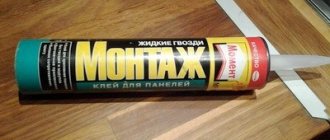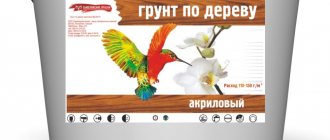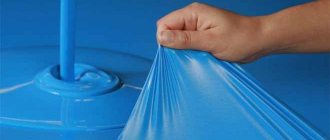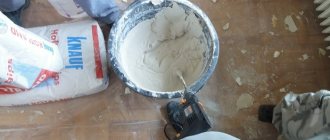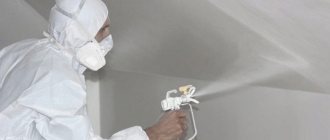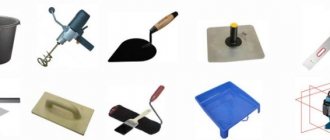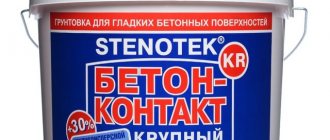Material Information
Bitumen primer is a black liquid that should not contain foreign inclusions. The composition contains no impurities harmful to human health, since petroleum bitumen dissolves in an organic composition.
- If the store sells ready-made soil, it should be mixed with a construction mixer before use.
- When purchasing a concentrate, you will have to prepare it for use; for this you will have to buy a special solvent, the class of which will be indicated on the packaging. It is worth noting that a concentrated primer is much more profitable than a ready-made one - it is more economical. It should be diluted strictly adhering to the proportions specified by the manufacturer.
- The primer has a specific odor, so it must be used in a well-ventilated area or outdoors.
- The primer increases adhesion and can be used for all types of surfaces: metal, wood, reinforced concrete, concrete, asbestos-cement, and various types of porous materials. Before waterproofing an underground structure or roof, the surface of communications or the foundations of buildings, you need to apply bitumen primer.
- The primer has an anti-corrosion effect, so using a primer on metal surfaces protects pipes from rotting and increases their service life.
- The primer can be used at any time of the year, even in hot weather, since its softening process begins at 80 degrees.
If the surface of the material is very porous and dusty, then for further processing with insulating materials, experts advise using a bitumen primer for a better result.
Bitumen primer and bitumen primer: technical characteristics
Bituminous soil is a special finely dispersed composition whose formula is based on bitumen. Rubber is also added to the mixture to give the soil maximum elasticity.
We recommend: How to treat drywall before wallpapering
A bitumen primer is used for priming concrete surfaces, sand-cement screeds, in the process of installing waterproofing, and before gluing roll materials in roofing works.
Types of bitumen primer compositions
There are several varieties of bitumen-based soils. The species gradation of the material is carried out on the basis of the components included in the primer. The composition of bituminous primers is:
- Ordinary. The mixture is made from bitumen and unleaded gasoline in a certain proportion;
- Polymer. Polypropylene is added to the soil;
- Mineral-bitumen with the addition of limestone;
- Rubber-bitumen. The soil contains crumb rubber fillers;
- Water. The peculiarity of this type of primer is that it is used mainly for interior work.
Also, all the types of primer described above can be divided into two types: ready-made and concentrated mixtures. The first type of material is simply stirred before use, but the concentrated solution will need to be diluted in the proportions specified by the manufacturer. As practice shows, it is more profitable to purchase concentrate, since it is economical in consumption.
The gradation of the material is also carried out according to its functional purpose and the following types of bitumen compositions can be distinguished:
- Road. Used to bind crushed stone pavement before applying asphalt;
- Roofing. Used to create reliable waterproofing and level the surface before finishing the roof;
- Pipeline. They are used for processing pipe elements to effectively protect surfaces from corrosion processes.
There are also universal bitumen primers that can be used on all types of surfaces.
Specifications and Features
Bituminous soil has special characteristics and properties:
- Provides the required level of adhesion of the base and waterproofing or roofing material;
- Strengthens the base by binding small particles and dust, efficiently filling pores and microcracks in the base. As a result, the surface becomes more durable;
- Bituminous soils must be used before waterproofing, as they can improve its quality;
- The use of soil helps to moisten the base to the required extent and thereby speed up the work on arranging the roof using fused materials;
- The composition also has anti-corrosion properties, which is especially important when treating metal surfaces.
When choosing a bituminous primer, you should definitely study the instructions for its use in order to select the appropriate composition according to the required strength, elasticity, and the presence of additives in the primer.
Primer types
There are several types of this product, the cheapest is simple primer. Bitumen-polymer material is much more expensive; it contains special substances that promote rapid drying, while at the same time isolating the surface much better from the effects of nature. Primer, bitumen emulsion – used for interior work, diluted with water.
Application and positive aspects of bitumen-based soil
Bitumen primer is similar in properties to plaster, and is intended to protect porous materials, only, unlike gypsum mixtures, it can be used for metal surfaces and in roofing work.
Impregnation of the base with bituminous soil is intended as a starting coating before using various waterproofing materials.
Due to its dense composition, the primer clogs all the pores of the material, making it resistant to moisture. Waterproofing of various structures using a bitumen primer becomes better.
Let's consider in which areas it is most preferable to use bitumen primer.
Scope of application
Primer is a primer designed to fill the pores of the material, level out small roughnesses and irregularities, and remove dust from the material. It is used for primary treatment and improving the adhesion of the waterproofing material to the base.
The material can also be used as independent surface insulation, in cases where the base is not constantly exposed to moisture.
Many builders use emulsion primers to coat surfaces in the bathroom and kitchen, where air humidity is high.
Now there are many types of this material on the market, which are used:
- for roof treatment;
- floor coverings;
- basements;
- foundations;
- sewer pipes and water supply systems.
The performance characteristics of each type of bitumen primer differ from each other, and you only need to use the material that is suitable for a particular type of surface.
Characteristics of bitumen impregnation:
- dries within three hours;
- the temperature range at which the primer can be applied is quite wide -40 +80 degrees;
- easy to apply, elastic material;
- breathable;
- easy to use and affordable.
Types and scope of application of bitumen primer in construction
Bitumen primer is a primer consisting of high-quality petroleum bitumen diluted in an organic diluent. You can buy the soil in concentrated form, and then dilute it yourself to the desired thickness, or you can buy a ready-to-use composition.
The primer is used for priming surfaces made of wood, concrete and metal, when constructing waterproofing. In this case, the installation of weld-surface insulators increases significantly.
Impregnation is used when performing roofing and waterproofing work, when installing soft tiles.
When using waterproofing mastic, the primer increases adhesion, which promotes better adhesion of the material to the surface.
Material Information
Bitumen primer is a black liquid that should not contain foreign inclusions. The composition contains no impurities harmful to human health, since petroleum bitumen dissolves in an organic composition.
- If the store sells ready-made soil, it should be mixed with a construction mixer before use.
- When purchasing a concentrate, you will have to prepare it for use; for this you will have to buy a special solvent, the class of which will be indicated on the packaging. It is worth noting that a concentrated primer is much more profitable than a ready-made one - it is more economical. It should be diluted strictly adhering to the proportions specified by the manufacturer.
- The primer has a specific odor, so it must be used in a well-ventilated area or outdoors.
- The primer increases adhesion and can be used for all types of surfaces: metal, wood, reinforced concrete, concrete, asbestos-cement, and various types of porous materials. Before waterproofing an underground structure or roof, the surface of communications or the foundations of buildings, you need to apply bitumen primer.
- The primer has an anti-corrosion effect, so using a primer on metal surfaces protects pipes from rotting and increases their service life.
- The primer can be used at any time of the year, even in hot weather, since its softening process begins at 80 degrees.
If the surface of the material is very porous and dusty, then for further processing with insulating materials, experts advise using a bitumen primer for a better result.
Primer types
There are several types of this product, the cheapest is simple primer. Bitumen-polymer material is much more expensive; it contains special substances that promote rapid drying, while at the same time isolating the surface much better from the effects of nature. Primer, bitumen emulsion – used for interior work, diluted with water.
Application and positive aspects of bitumen-based soil
Bitumen primer is similar in properties to plaster, and is intended to protect porous materials, only, unlike gypsum mixtures, it can be used for metal surfaces and in roofing work.
Impregnation of the base with bituminous soil is intended as a starting coating before using various waterproofing materials.
Due to its dense composition, the primer clogs all the pores of the material, making it resistant to moisture. Waterproofing of various structures using a bitumen primer becomes better.
Let's consider in which areas it is most preferable to use bitumen primer.
Scope of application
Primer is a primer designed to fill the pores of the material, level out small roughnesses and irregularities, and remove dust from the material. It is used for primary treatment and improving the adhesion of the waterproofing material to the base.
The material can also be used as independent surface insulation, in cases where the base is not constantly exposed to moisture.
Many builders use emulsion primers to coat surfaces in the bathroom and kitchen, where air humidity is high.
Now there are many types of this material on the market, which are used:
The performance characteristics of each type of bitumen primer differ from each other, and you only need to use the material that is suitable for a particular type of surface.
Characteristics of bitumen impregnation:
- dries within three hours;
- the temperature range at which the primer can be applied is quite wide -40 +80 degrees;
- easy to apply, elastic material;
- breathable;
- easy to use and affordable.
Types of bitumen primers
Manufacturers of this type of primer for waterproofing produce a wide range of materials with different properties, for example, different brands of product:
- Primer intended for deep impregnation of concrete surfaces, foundation blocks, self-leveling floor coverings, sand-cement plasters.
- For insulating wooden decks or walls.
- Material for processing pipes and metal spans when waterproofing work is planned.
- Emulsion primer that can be applied to a damp surface indoors.
All impregnations can be applied with a brush or roller. Before treatment, the surface should be thoroughly treated - cleaned of old coating and degreased.
Universal formulations
In addition to specialized formulations, manufacturers produce universal acrylic-based materials that can be diluted with water.
A universal bitumen primer primer, used in residential premises, while its composition contains antiseptic additives and has antifungal properties.
We recommend: Scope of application and procedure for applying primer Ceresit ST 16
This material can be applied to any surface:
- brick;
- aerated concrete;
- plaster;
- concrete;
- Fiberboard;
- drywall;
- chipboard;
- DSP.
Universal foundation primers are used for exterior work, when it is planned to apply decorative plaster to the base plaster layer. The material is vapor permeable, while protecting the surface from adverse weather conditions.
Universal bitumen soil has the following advantages:
- high adhesion of the base and material;
- allows air to pass through;
- makes the base waterproof.
Primer consumption
This indicator directly depends on the material to be processed, for example:
- if a plastered base is being processed, then it will presumably take 300 grams per 1 m2;
- If you apply impregnation to a puttied surface, then the material consumption will be exactly half as much.
Material consumption depends on the manufacturer and the concentration of the composition. If we consider a solution that is sold in a ready-to-use form, it will take much more than a concentrated composition diluted with a solvent.
Application in roof construction
Bitumen primer for waterproofing is a class of primers that is among the best materials used in roofing. By using this material, you can be confident in the quality of the work performed, if the base was prepared correctly.
Before treatment, the surface must be cleaned of dust; there should be no substances on it that reduce adhesion. Sometimes, the surface is additionally degreased.
You can apply the primer in any convenient way:
- roller;
- brush;
- spray gun;
- airless spraying;
- pour onto the surface and smooth with a special rubber roller.
Concentrated bitumen primer for roofing is diluted with white spirit or gasoline. At the same time, iron, concrete and asphalt can be treated with this solution.
When working with the material, care must be taken as it is flammable. Do not work with open flame until the primer has completely dried.
Try to avoid contact of the material with mucous membranes and exposed skin. If the primer gets into your eyes while working, you should, after rinsing with plenty of water, contact an ophthalmologist for consultation, otherwise you may lose your vision.
Foundation treatment
By using bitumen impregnation when carrying out waterproofing work on the base of a structure, you can be confident in the quality and durability of the coating. It is important to correctly calculate the consumption of bitumen primer, so that there is enough material to treat the foundation on both sides, in this case the base will be resistant to moisture.
Before applying the surface-mounted insulators, the impregnation must dry well; for greater reliability, you can apply a bitumen primer in two layers. In this case, even a porous foam block will become waterproof.
It is advisable to use deep penetration impregnation on a bitumen basis in damp rooms:
- kitchens;
- bathrooms;
- laundries;
- showers.
Bituminous mastic for surface insulation
When using a primer as a primer, it is advisable to waterproof the surface with mastic, which can be applied cold or hot.
The material is sold in construction stores, and its cost depends on the components and additives included in its composition. The cheapest is mastic, which must be heated before application - a hot-use material.
This method of arranging waterproofing was very popular until recently, until mastic, based on bitumen and solvent, ready for use, appeared. These compositions do not require heating before use and are applied with a brush or roller.
As soon as the solution hits the surface that needs to be insulated, the solvent begins to evaporate rapidly, and the bitumen hardens, forming a durable waterproofing film. If the purchased material is too viscous, or you purchased a concentrate, then you can dilute the composition with white spirit or a solvent recommended by the mastic manufacturer.
Make your own mastic
Even with a small construction budget, you should not neglect waterproofing - the durability of the structure depends on it. There is no money for ready-made mastic, it’s okay, you can make it at home with your own hands. How to do it:
- Prepare the ingredients: plasticizer, bitumen, filler. The material is purchased in the required quantity depending on how much waterproofing material you need. Let's consider an example of preparing 10 kilograms of mastic, for this you will need: 8.5 kg - bitumen;
- 1 kg – filler;
- 0.5 kg – plasticizer.
The filler for mastic can be rubber chips, sawdust or mineral wool. To make the material plastic, you need to add used engine oil or kerosene to it.
- The mastic is prepared in a large thick-walled container. Before putting it on the fire, you need to put bitumen, well crushed, and filler, the fraction of which should be fine.
The container should not be filled to the brim, since when melted, the bitumen greatly increases in volume.
- The mastic cooking temperature should be no more than 190 degrees, as the bitumen may begin to peel off, which will lead to damage to the material. The foam from the surface of the bitumen must be constantly removed and a plasticizer must be introduced in portions.
- The mastic is ready after all the components are introduced into the bitumen.
The composition, prepared independently, is not stored for a long time - only a day. As soon as the mastic has cooled to 120 degrees, it can be applied to the surface.
How to make your own primer
A material such as a bitumen-based primer can be prepared with your own hands. To prepare the composition you need to take three parts gasoline and one part bitumen.
Application of coating waterproofing
Coating waterproofing is a thin-layer moisture-proof frost-resistant protective coating. In most cases, to protect the foundation from moisture, bitumen-based mastic is used - the most affordable and cost-effective composition for creating a moisture-proof coating. Bitumen mixtures are used on metal, wood, concrete, reinforced concrete, brick and other mineral surfaces .
Application area:
- processing of walls, foundations, basements, swimming pools, reservoirs, hydraulic and other structures;
- protection from moisture of vertical and horizontal surfaces;
- for external and internal works.
Return to content
Calculation of the required volume
The required amount of bitumen primer can be determined based on the surface area that needs to be treated and the average consumption of the solution per 1 square meter.
The average consumption of the finished primer is indicated by the manufacturer on the packaging; for a primer made independently it is 0.5 liters per 1 square meter.
The application of bitumen primer, according to technology, occurs in 2-3 layers, so it is important to increase the amount of calculated material by 2 or 3 times.
Well-known manufacturers of bitumen primer, examples of their products
Primers, especially popular on the Russian market, are produced by. A classic example of its products is the bitumen primer “Techno Nicole No. 01”. This is a ready-to-use, quick-drying composition for priming substrates.
Its concentrated version is the TechnoNikol No. 02 primer. It is used in cases where it is necessary to process very large surface areas. In these cases, it is more rational to buy a smaller number of buckets - in order to dilute the composition yourself, in the proportion indicated on the package. Primer “TechnoNikol No. 03” comes with the addition of polymers. These additives increase the adhesion properties of the composition, as well as increase its waterproofing properties and make the coating more durable. Another type of such an improved primer is TechnoNikol AquaMast.
Another popular primer in Russia is the Oreol brand. It is made on a bitumen-rubber base and is used for outdoor use (priming surfaces).
DECKEN brand primers are also used successfully. Like products from TechnoNikol, they are available in two versions: a cheaper one-component version, or with the addition of polymers (“DECKEN bitumen-polymer primer”).
All of these products have rightfully gained wide popularity and an impeccable reputation in the market. The consumption of the finished primer (as well as the diluted concentrate) is 250-350 ml per square meter of surface.
How to calculate the required quantity?
Knowing some nuances will help you more accurately calculate the amount of bitumen primer. Thus, a primer in a hot volume always diverges in a larger volume than a cold one. Although the hot primer is considered more sensible and practical.
It also matters what tool you are going to use - a brush or a roller, and what surface you will apply the composition to. Rollers require less material, and the vertical walls of the parapet require two or three layers, and each of them must dry well in turn.
And for a horizontal surface, the number of layers varies each time, depending on the task. For example, to glue roofing felt, one layer of primer will be enough, but to install a mastic roof, two or three layers will be enough. The surface area itself is easy to calculate.
Material Specifications
- Density – 850-900 kg/m3;
- Application temperature - +5-+30 degrees Celsius (work should be carried out at this temperature);
- Material consumption – up to 300 grams per square meter;
- Operating temperature – from -40 to +60 degrees Celsius;
- Drying period – 3-4 hours.
It is worth noting that the parameters described above, especially drying time, can vary greatly depending on the manufacturer. Moreover, in all cases, this material is highly flammable, so it must be used away from sources of open flame, and the container itself must be left sealed between uses. At the same time, it is also necessary to close it in order to isolate vapors characteristic of compositions based on organic solvents.
Materials and tools
When processing the foundation yourself with a primer, you will need:
- Bitumen primer;
- Solvent (if a concentrated solution is used) - gasoline, white spirit, etc.;
- Wide brush or roller of your choice;
- Tray or other container for solution;
- Protective elements – mask, gloves, goggles;
- Brush and coarse cloth.
Also, if there are various defects on the foundation, a spatula, putty, hammer and other tools can be useful to help solve the problem.
Standards of use
The consumption rate of bitumen primer per 1 m2 was mentioned above, but to achieve a positive result it is also important to know the technology of the work. The mixture is applied to cement-sand, concrete and other rough surfaces. If we are talking about a porous, dusty and uneven surface, then the treatment must be carried out using a brush or nylon brush. This application technology provides excellent impregnation of the base and high adhesion rates.
Surface priming allows you to increase the service life of materials. If there is a need to glue roll materials using a primer, the surface of reinforced concrete and concrete slabs, as well as the seams between the elements, must be primed. Each subsequent layer of rolled material is glued 4 hours after installation of the previous one. Rolled materials must be laid with an overlap, the width of which is 100 millimeters. In this case, cross-gluing should be avoided. Once the web is in place, it should be rolled with a special-purpose cylindrical roller.
Execution of work
The technology for waterproofing a foundation with a primer is quite simple and consists of several steps:
- Prepare the primer - mix the prepared solution thoroughly, dilute the concentrated primer, according to the instructions, with a suitable solvent;
- Pour the liquid into a convenient container and, using a wide brush or roller, apply an even layer to the cleaned surface;
- Wait the required time for the surface to dry completely and cover the base with the next layer of primer.
It is recommended to carry out foundation treatment work at a temperature not lower than -15 degrees Celsius.
When treating the base with a bitumen primer, you should be attentive to your own safety: during work, you must wear a mask and goggles to protect your mucous membranes from toxic fumes, as well as thick clothing that minimizes the possibility of bitumen getting on your bare skin.
Safety precautions
When working with bitumen primer or primer, the following safety precautions must be observed:
- the material contains flammable organic solvents, so it is necessary to have fire extinguishing equipment at the construction site;
- When working with primer/primer, smoking and using open fire are prohibited;
- The primer (primer) is not allowed to get into the eyes and mouth, as well as onto open areas of the skin. In case of contact with eyes, rinse them with plenty of water and consult a doctor;
- When carrying out work on applying primer, it is recommended to use safety glasses and gloves.
Application Features
For small volumes, rollers are most often used.
The procedure for working with bitumen primers is quite simple. The instructions do not require special knowledge or skills; it is enough to follow its points:
- The base on which the composition is applied must be cleaned of dust and loose parts.
You should take the preparation of the foundation seriously.
- According to the manufacturer's instructions, the composition must be prepared. This may be by heating or diluting with a solvent. As a rule, mastics are diluted for spray guns.
Prepare the material according to the manufacturer's instructions.
- When working with roofing, the substance is poured and smoothed with rubber squeegees. During large-scale construction, spray guns are used;
The composition can be poured onto a flat roof.
- Then rubber, polymer or bitumen materials are glued, depending on the specific work;
Roll material is glued onto the mastic layer.
- If the composition is used independently, it is often necessary to apply a second layer;
Despite the fact that the price of the material can be high, several layers are often required.
- At the end, it is necessary to create conditions for normal hardening of the primer layer . They are described in the instructions for the specific substance.
Allow the composition to dry properly.
When working with solvent-based mastics, be sure to use gloves, goggles and respirators. Do not work near open flames and do not smoke while doing so.
Making your own bitumen primer
If you wish, you can prepare a bitumen primer yourself; for this you will need the following materials:
- 1 kg bitumen,
- 2.5 liters of unleaded gasoline,
- Container for heating bitumen,
- Metal fine mesh sieve,
- Container for mixing liquids,
The manufacturing process is not complicated:
- Melt the bitumen to a liquid state;
- Leave the mass for some time until it cools - the optimal temperature for work is 80 degrees;
- Gradually mix the cooled bitumen with gasoline - add the mixture in small portions and mix thoroughly;
- Using a sieve, strain the resulting mass.
Primers TechnoNIKOL
TechnoNIKOL Corporation is one of the Russian market leaders in the production of bitumen mixtures for various applications.
TechnoNIKOL 01
Bitumen primer TechnoNIKOL 01 is considered one of the most popular universal waterproofing materials. This is a classic version of a ready-to-use bitumen mixture based on organic solvents. Widely used in roofing work, and as an independent waterproofing for concrete and cement surfaces.
Primer TechnoNIKOL 02 is a concentrated analogue of TechnoNIKOL 01. The concentrate is more convenient for transportation and when used in large volumes. Before use, the mixture is diluted with white spirit or kerosene in a ratio of 1:1.5 – 1:2 by volume and mixed thoroughly. It is acceptable to use gasoline solvent.
TechnoNIKOL 03
Bitumen-polymer primer Technonikol 03 has increased adhesive and hydrophobic properties due to the additives included in its composition. The composition is used for processing metal and non-uniform surfaces, pipelines and bridge structures. It is sold as a ready-to-use bitumen primer.
TechnoNIKOL 04
TechnoNIKOL 04 is an emulsion bitumen primer, i.e. ready-to-use aqueous bitumen emulsion. It is used for interior work (for example, for treating the floor in the bathroom). Since the composition does not use organic solvents, the mixture does not have a strong odor and does not emit harmful fumes. Drying time for the primer at room temperature is no more than an hour.
The water base allows you to apply TechnoNIKOL 04 primer to wet surfaces.
AquaMast
Primer AquaMast is an environmentally friendly primer based on organic solvents for pre-treatment of surfaces. A special feature of the AquaMast composition is that it can be used both in combination with roll materials and when installing coating waterproofing.
The use of bituminous soil can significantly reduce the consumption of waterproofing mastic.
| Indicators | 01 | 03 | 04 | AquaMast |
| Primer consumption, l/m2 | 0,25-0,35 | 0,25-0,35 | 0,25-0,35 | 0,35 |
| Drying time at 20 0C, h | 12 | 10 minutes | 1 | 12 |
| Application temperature, 0C | from -20 to +40 | from -20 to +40 | from +5 to +30 | from -10 to +40 |
Table 1. Technical characteristics of TechnoNIKOL primers
Healthy competition for the TechnoNIKOL corporation comes from the Vitumast company, which offers its line of bitumen primers with similar technical characteristics.
When choosing a universal primer, the golden rule “price – quality” applies. It is better to ask your sales consultants in more detail about the properties of special-purpose mixtures.
Properties of bitumen-polymer mastics and primers
Although all polymer-bitumen compositions are conventionally classified into one group, the properties of modified mastics vary greatly depending on the type of additive. Moreover, strengthening properties in one aspect leads to loss of qualities in another. Therefore, when purchasing, focus on the composition:
We recommend: Priming walls before and after puttying: rules and tips
APP materials are distinguished by such qualities
- UV resistance.
- Resistant to aggressive alkalis and acids.
- High melting threshold.
- Resists fatigue from repeated use and shows no signs of aging.
- Increased adhesion to smooth surfaces - glass, metal.
SBS materials are characterized by increased ductility:
- Retains elasticity at low temperatures.
- The elasticity of the coating does not change over a wide range of base temperatures from -40 to + 80.
For laying tiles, similar bitumen compositions with SBS polymers are used.
These lists are used crosswise when talking about qualities that the mixture does not possess.
The properties of solvent-based primers differ from water-dispersion ones. While compositions with solvents are characterized by a high drying rate, emulsions are environmentally friendly and can be used indoors without risk to health. Aqueous formulations have better penetrating ability because they have a lower viscosity compared to solvent-based primers.
Bituminous mastic for surface insulation
When using a primer as a primer, it is advisable to waterproof the surface with mastic, which can be applied cold or hot.
The material is sold in construction stores, and its cost depends on the components and additives included in its composition. The cheapest is mastic, which must be heated before application - a hot-use material.
This method of arranging waterproofing was very popular until recently, until mastic, based on bitumen and solvent, ready for use, appeared. These compositions do not require heating before use and are applied with a brush or roller.
As soon as the solution hits the surface that needs to be insulated, the solvent begins to evaporate rapidly, and the bitumen hardens, forming a durable waterproofing film. If the purchased material is too viscous, or you purchased a concentrate, then you can dilute the composition with white spirit or a solvent recommended by the mastic manufacturer.
Make your own mastic
Even with a small construction budget, you should not neglect waterproofing - the durability of the structure depends on it. There is no money for ready-made mastic, it’s okay, you can make it at home with your own hands. How to do it:
- Prepare the ingredients: plasticizer, bitumen, filler. The material is purchased in the required quantity depending on how much waterproofing material you need. Let's consider an example of preparing 10 kilograms of mastic, for this you will need: 8.5 kg - bitumen;
- 1 kg – filler;
- 0.5 kg – plasticizer.
The filler for mastic can be rubber chips, sawdust or mineral wool. To make the material plastic, you need to add used engine oil or kerosene to it.
- The mastic is prepared in a large thick-walled container. Before putting it on the fire, you need to put bitumen, well crushed, and filler, the fraction of which should be fine.
The container should not be filled to the brim, since when melted, the bitumen greatly increases in volume.
- The mastic cooking temperature should be no more than 190 degrees, as the bitumen may begin to peel off, which will lead to damage to the material. The foam from the surface of the bitumen must be constantly removed and a plasticizer must be introduced in portions.
- The mastic is ready after all the components are introduced into the bitumen.
The composition, prepared independently, is not stored for a long time - only a day. As soon as the mastic has cooled to 120 degrees, it can be applied to the surface.
How to make your own primer
A material such as a bitumen-based primer can be prepared with your own hands. To prepare the composition you need to take three parts gasoline and one part bitumen.
Varieties of bitumen-based compositions
Bituminous primer, depending on its components, can be:
- Simple. It consists of bitumen and unleaded gasoline in a ratio of 1:3. It is quite possible to make such a mixture yourself.
- Polymer primer is produced with the addition of polypropylene (powder or atactic) to its composition. It costs a little more than a simple one. When purchasing, in order not to purchase a fake, you must check the quality certificate.
- The mineral-bitumen mixture is produced with the addition of dolomatized and asphalt limestones. A certificate confirming these qualities is required.
- Rubber-bitumen contains fillers from rubber waste. Most often, shredded rubber tires that have expired are added to it.
- Aqueous bitumen emulsion. This soil-mixture is made on the basis of bitumen and water, used for interior work, most often it is used to cover concrete floors in rooms. It has low toxicity and requires a small consumption of the drug per 1 m². When purchasing, be sure to check all the characteristics specified in the certificate.
Varieties of bitumen-based compositions
According to the generally accepted classification, bitumen primer is divided into 2 types:
- Ready-made emulsion, when the primer just needs to be stirred well before use.
- Concentrate. This primer is diluted to the required consistency with kerosene, gasoline or other organic solvents, as indicated in the attached instructions. This form of release ensures more economical use of the drug and facilitates its storage and transportation.
By purpose it can be:
- Road. Binds crushed stone before applying asphalt pavement. In private construction it can be used before applying concrete screed on the street.
- Roofing. It is used for waterproofing and leveling the base before the final roof covering. The selection of such coverage is very responsible; you should not purchase an unknown product without a certificate.
- Pipeline. Used to protect metal from corrosion.
- Universal. Suitable for use on all types of surfaces (wood, concrete, sand slab).
Technology for performing bitumen waterproofing of foundations
Work on installing waterproofing with bitumen compounds is carried out in several stages:
1) preparation of the base;
2) applying a primer for the foundation;
3) applying bitumen mastic.
Preparing the base.
At the initial stage of work, the surface of the foundation is cleaned of various types of contaminants (debris, dirt, dust) and the technical condition of the concrete base is assessed.
If there are a large number of holes, chips and bubbles, the surface should be smoothed using fine-grained cement mortar.
It is also necessary to make a smooth transition at the junction of the horizontal and vertical parts of the supporting structure.
The main criterion for the readiness of the foundation for applying waterproofing is the level of humidity.
The surface of the base must be as dry as possible, otherwise, the formation of blisters or complete peeling of the waterproofing layer is possible.
You can check the readiness of the foundation for applying waterproofing using one simple method: place a 1x1 m piece of polyethylene film on the surface and if condensation does not form under the film over the next 24 hours, then you can proceed to the next stage of work.
Primer application
. The foundation surfaces are treated with a primer to increase adhesion. The primer is applied using a roller or brush. To treat the base of the foundation, it is enough to apply the primer in one layer; the abutments should be treated twice.
Application of bitumen mastic.
The mastic is applied after the primer layer has dried. Bitumen waterproofing of the foundation involves the use of bitumen solutions or emulsions, asphalt or bitumen-polymer mastics.
The foundation is treated with bitumen mastic in several layers, the number of which depends on the depth of the supporting structure. If the foundation is laid underground to a depth of 2 m, the mastic is applied in 2 layers, at a depth of over 2 meters and up to 5 - in 3-4.
Applying a new layer begins after the previous one has dried. The drying speed depends on the type of waterproofing material, temperature and air humidity.
The waterproofing material is applied from the bottom up, starting from the base of the foundation and ending at a height of 150-200 mm from the ground surface.
Depending on the consistency of the mastic, the waterproofing material is applied using a roller, brush, spatula or spray. It is important to maintain the same layer thickness at all points of the surface being treated and to avoid gaps.
When installing bitumen waterproofing in particularly vulnerable areas of the foundation, such as abutments, cold seams and interfaces, a reinforcing layer is provided.
Reinforcement of waterproofing is carried out using fiberglass materials, which are laid in designated areas when applying the first layer of mastic.
Bitumen-based primer
Description of material
The photo shows a repair of a garage roof using a primer.
Bituminous primer is a building material intended for preparing surfaces for waterproofing, gluing roll coverings and installing roofs. In addition, bitumen mastics are used as an independent waterproofing agent.
The technology for producing most waterproofing work in construction requires the use of bituminous soils. If previously molten resin was used for these purposes, today the market offers much more convenient and advanced materials.
Bitumen-coated industrial communications.
Waterproofing of various construction projects is rarely complete without the use of bitumen mastics, primers and primers. These are reliable and easy-to-use compositions that are easy to apply with your own hands in individual projects or using industrial methods - in industrial ones.
Purpose and varieties
Dried mastic on the roof.
The purpose of a bitumen primer may vary depending on the area of its application. There are several main purposes:
- Preparation of a mineral base (concrete, plaster) for gluing roll materials on a bitumen or rubber base. This can be roofing felt, roofing felt, PVC membrane, various rubber coatings for waterproofing. The primer closes pores and levels the base, reducing the consumption of other materials;
Applying mastic to concrete.
- Adhesive base for applying winding waterproofing to pipelines, roll waterproofing to foundation walls, etc.;
- Self-waterproofing for metal, wood, brick and other surfaces. Bitumen mastics adhere well to surfaces and reliably protect them from moisture and environmental influences;
The primer adheres well to wooden products and prevents them from rotting.
- Material for installation and repair of roofs, most often flat ones, where slate and other similar coatings are not used. Used to increase adhesion between coatings and slabs, as well as between coating layers.
Repairing a flat roof using mastic.
According to GOST 30693-2000, mastics are divided into the following types:
- By purpose - roofing, gluing, waterproofing;
- By composition - bitumen, bitumen-polymer, bitumen-emulsion, bitumen-rubber and polymer;
- By solvent – aqueous and based on organic solvents;
- According to the nature of hardening - hardening, vulcanizing, non-hardening;
- According to the method of application - cold and hot.
Gluing rubber mats onto a bitumen primer.
Water-based primers are most suitable for the definition of a primer, since they penetrate deeply into the mineral base and increase its adhesion to the polymer, rubber or bitumen coating. In addition, aqueous primers are used before applying bitumen-polymer mastics to reduce the consumption of the latter.
Treating the foundation with a primer before applying the main layer of waterproofing.
Specifications
Applying the material using a spray gun reduces consumption and increases productivity.
Technical characteristics of bitumen primer, as well as requirements for various compositions, are described in GOST 30693-2000. They can vary widely depending on the specific substance.
